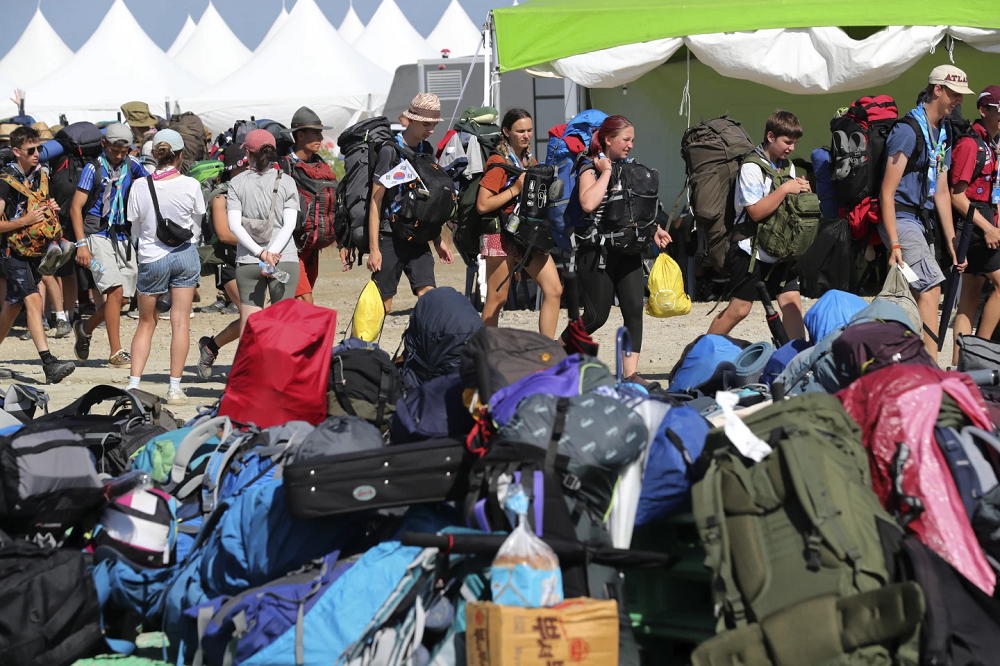Buses began moving tens of thousands of Scouts to inland venues ahead of a tropical storm Tuesday, bringing an effective end to a World Scout Jamboree that had already struggled with heat, hygiene and land use controversies.
Known for its insatiable desire to host international events, the South Korean government scrambled to keep the 12-day gathering of Scouts from around the world going as thousands of British and American Scouts departed over the weekend because of an extreme heat wave that caused some attendees to be hospitalized.
It wasn’t until Monday afternoon that officials announced the decision to abandon the coastal campsite in the southwestern town of Buan, after forecasters raised alarms that Tropical Storm Khanun was heading toward the Korean Peninsula.
South Korean officials say the Jamboree will continue in the form of cultural events and activities, including a K-Pop concert in Seoul Friday.
Critics have argued the decision to host the Jamboree at a site known as Saemangeum was part of an effort to justify further investment in a controversial swath of reclaimed land.
Concerns had been raised beforehand about having such large numbers of young people in a vast, treeless area lacking protection from heat. Hundreds of participants were treated for heat-related ailments after the Jamboree began, as South Korea grappled with one of its hottest summers in years.
The government insisted the event was safe enough to continue and channeled resources to keep the event going, adding medical staff, air-conditioned buses, military shade structures, and hundreds of workers to maintain bathrooms and showers, which some Scouts had complained were filthy or unkempt.
Saemangeum is the result of a 19-year project to build a 33-kilometer (21 mile) seawall, which South Korea describes as the world’s longest.
Since the wall was finished in 2010, the land remained a largely barren site as local officials pursued plans for highways, ports and an international airport. Once seen as a major development project for a region lacking an industrial base, it’s now increasingly viewed as an ecological disaster that wiped out coastal wetlands and hurt fisheries production.
Critics have argued the push to host the Jamboree at Saemangeum was part of efforts to justify further investment in the site.
In a 2018 document describing its successful bid to host, the North Jeolla provincial government wrote that its main reason for hosting the event was to lure badly needed infrastructure investment to the area after initial plans didn’t progress as hoped.
“North Jeolla Province needed a project that could spur the construction of an international airport and other SOC (social overhead capital) investments to further encourage the development of Saemangeum’s inner areas,” provincial officials wrote, using an acronym that refers to infrastructure projects.
Local officials continue to pursue plans for new highways, ports and an international airport. The airport was initially supposed to be built for the Jamboree, but construction hasn’t started yet.
Organizers said the campsite will not be used for any other events after the Scouts leave.
Tropical Storm Khanun has meandered around Japan’s southwestern islands for more than a week, dumping heavy rain, knocking out power and damaging homes.
Early Tuesday morning, the storm was centered 350 kilometers (217 miles) south of Kagoshima, a city on the southwestern tip of Japan’s main southern island of Kyushu. Khanun produced winds of 108 kph (67 mph) with gusts to 144 kph (89 mph) and was slowly moving north, the Japan Meteorological Agency reported.
South Korea’s weather agency, which measured the storm at typhoon strength of 126 kph (78 mph), expected it to gain strength slightly before making landfall Thursday morning. It’s expected to bring strong winds and heavy rains to South Korea from Wednesday to Friday.
South Korea’s safety ministry instructed local officials to prepare to shut down coastal areas, hiking trails, river parks, underpass tunnels and other places vulnerable to flooding.
More than 1,000 vehicles are being used to evacuate 37,000 Scouts hailing from from 156 countries, mostly teenagers. Most will be accommodated in Seoul and the surrounding area, where officials have secured university dormitories, government and corporate training centers, and hotels, with others sent to other provinces in the country’s north and middle.
More than 270 police cars and four helicopters were deployed to escort the buses, said Lee Sang-min, South Korea’s Minister of the Interior and Safety.
The evacuation began at 9 a.m. and about 60% of the buses had left the campsite by 4 p.m., the government said. The evacuation is expected to take six hours or more.
“This is the first time in more than 100 years of World Scout Jamborees that we have had to face such compounded challenges,” said Ahmad Alhendawi, secretary general of the World Organization of the Scout Movement, who credited South Korea’s government of “mobilizing all available resources” into the relocation effort.
“It’s disappointing that these adverse weather conditions have forced us to shift our plans,” he said.

